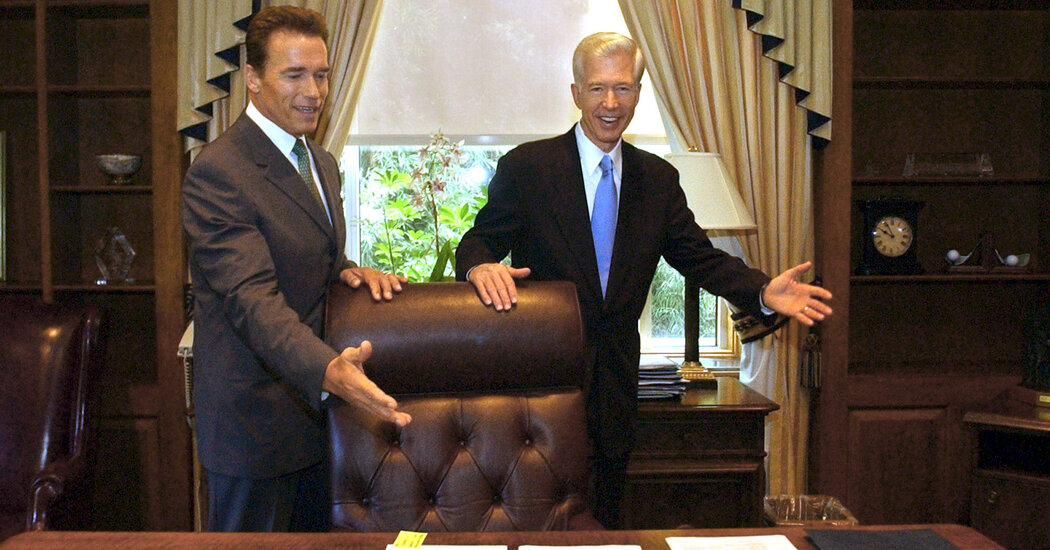As Californians who haven’t already voted by mail head to the polls for the recall election of Gov. Gavin Newsom on Tuesday, they may be reminded o
As Californians who haven’t already voted by mail head to the polls for the recall election of Gov. Gavin Newsom on Tuesday, they may be reminded of a similar election 18 years ago. In 2003, another Democratic governor, Gray Davis, was recalled and replaced by Arnold Schwarzenegger.
It’s easy to draw parallels between the two races. While Mr. Davis was criticized for his handling of an electricity crisis, Mr. Newsom has been faulted for his handling of the coronavirus pandemic. In both years, dozens of candidates across the political spectrum qualified for the ballot as potential replacements. And like the 2003 race, this year’s contest is expected to have high turnout for an off-cycle election.
Despite these similarities, the two elections are quite different in several notable ways.
California’s increasingly Democratic lean
California has been reliably blue for decades, voting for the Democratic nominee in every presidential election starting in 1992. But the degree to which the state leans left has increased significantly in recent years because of changing demographics and Democratic gains with white college-educated voters.
In 2000, Al Gore won California by 12 percentage points. In 2020, Joe Biden won the state by 29 points. The Democratic trend can also be seen at the governor level. While Mr. Davis won re-election by just five percentage points in 2002, Mr. Newsom prevailed by 24 in 2018.
The state’s second- and third-largest counties by population, San Diego and Orange, epitomize California’s increasing Democratic lean. George W. Bush carried San Diego County by four percentage points in 2000, while Mr. Biden carried it by 23 points in 2020. Mr. Bush carried Orange County by 15 points in 2000; Mr. Biden by nine in 2020.
California’s heavily Democratic partisan baseline makes it extremely difficult for a Republican to win a statewide election without winning significant crossover support from Democratic-leaning voters.
Political polarization steepens this challenge for California Republicans, just as it has become increasingly hard for Democrats to win races in heavily Republican states like Tennessee, Indiana and Arkansas.
Changing demographics
A major reason Democrats have gained ground is California’s increasing diversity.
America’s demographics have changed significantly in the last 20 years, and California is no exception. According to the census, 46.7 percent of Californians were non-Hispanic white in 2000. By 2020, that fell to 34.7 percent.
At the same time, Hispanic and Asian American shares of the population have grown. The percentage of Hispanic residents (of any race) increased to 39.4 percent from 32.4 percent, while the percentage of Asian residents (Asian alone or in combination with another race) increased to 17.8 percent from 12.3 percent.
Approval ratings
Perhaps the biggest difference between this election and 2003 is that Mr. Newsom has a substantially higher approval rating than Mr. Davis had when he was removed from office.
According to 2003 exit polls, Mr. Davis’s approval rating was at just 26 percent, with 73 percent disapproving, on Election Day. Voters were deeply dissatisfied, blaming him for the skyrocketing bills and rolling blackouts that emerged from the electricity crisis.
Recent polls show California voters generally think Mr. Newsom is doing a good job. A YouGov poll found 53 percent of likely voters approved of his performance, with 38 percent disapproving. Another poll from the Public Policy Institute of California found similar results, with likely voters at 53 percent approve and 43 percent disapprove.
While voter anger over coronavirus-related policies like business closures and stay-at-home orders helped get the recall on the ballot, Mr. Newsom has received positive marks on his handling of the pandemic. The YouGov poll found that 55 percent of likely voters rated his handling of the virus outbreak as “excellent” or “good,” while the Public Policy Institute of California poll found that 58 percent of likely voters approved of his response to the pandemic.
Republican opponents
Another key difference between 2003 and 2021 is the profile of each leading Republican candidate.
In 2003, Mr. Schwarzenegger was extremely popular among California voters and Americans in general. One Gallup poll found 79 percent of registered voters in California had a favorable opinion of him, while a CNN/USA Today/Gallup poll showed 72 percent of Americans liked him.
Beyond Mr. Schwarzenegger’s appeal as a popular actor, he also carved out a more ideologically moderate profile on a number of issues. In one radio interview on “The Sean Hannity Show,” he said he supported abortion rights; expressed opposition to offshore drilling; and voiced support for stricter gun control laws.
This year, the leading Republican challenger is the conservative talk radio host Larry Elder. In contrast with Mr. Schwarzenegger’s efforts to distance himself from conservative orthodoxy, Mr. Elder has taken conservative stances on hot-button issues like abortion, the minimum wage and climate change. He has also vowed to repeal the state’s mask and vaccine mandates, something that Mr. Newsom’s campaign has emphasized in negative advertisements.
Although recall elections are framed on the ballot as a referendum on the incumbent, Democrats have worked hard to elevate Mr. Elder’s profile and frame the contest as a clear choice between two candidates. The idea is that if voters feel lukewarm about Mr. Newsom, they may still prefer him to the alternative.
The state of the race
The most recent polls have given Mr. Newsom about a 17-percentage-point advantage in his effort to remain in office. While polls in recent years have tended to underestimate Republicans in Midwestern battleground states, this does not appear to be the case in California. Polls accurately estimated Mr. Biden’s margin in California last year, and even underestimated Mr. Newsom’s winning margin in 2018.
www.nytimes.com
